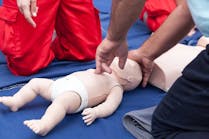Take aim at costs, quality and outcomes with high-quality medical supplies
The old ways of doing business no longer apply in healthcare. In this era of payment reform, health systems and hospitals must deliver higher quality care at a lower cost. The supply chain accounts for as much as 30 percent of a hospital’s total expenses, behind only labor, presenting a significant opportunity for savings. So why not just purchase the cheapest medical supplies available? It’s not as simple as it seems.
It all comes down to value. The fundamental principle behind healthcare reform is the shift from volume to value-based care. The volume of care no longer drives healthcare organizations’ revenue; rather they are reimbursed based on the value of care delivered. In order to deliver value, the organization must strike a balance between cost and quality. In terms of supplies, this means a purchasing strategy that meets both operational/financial goals (e.g. competitive pricing, contract compliance, less waste) and clinical goals (e.g. high-quality patient outcomes with fewer complications).
This balance is at the heart of the Institute for Healthcare Improvement’s (IHI) Triple Aim initiative. The IHI believes that in order to optimize health system performance, an organization must simultaneously address the three dimensions of the Triple Aim:
- Improving the patient experience of care (including quality and satisfaction);
- Improving the health of populations; and
- Reducing the per capita cost of healthcare.
As health systems and hospitals have worked to align their strategies with the Triple Aim, they have established value analysis committees (VAC) tasked with evaluating how product purchases impact these three areas. The result has been a more holistic approach to purchasing, where clinicians, supply chain professionals and other stakeholders (e.g. infection control, risk management) come together to determine how products impact cost, quality and outcomes beyond the initial acquisition and use.
For example, a hospital might choose to purchase the cheapest ventilator on the market as a way to cut its capital supply budget, but that product will only increase costs and lower care quality in the long term if the respiratory therapist’s workflow is constantly interrupted. When a patient interface is ill fitting or uncomfortable to the patient it can disrupt his or her therapy. Non-compliance with therapy can lead to intubation or more days in an intensive care unit (ICU) – increasing costs and further exposing the patient to infections, such as ventilator-associated pneumonia (VAP). At a time when the Centers for Medicare & Medicaid Services (CMS) and other payors are penalizing health systems and hospitals for preventable complications, organizations simply can’t afford to cut corners.
While most VACs are performing rigorous evaluations of expensive capital equipment, software and implant acquisitions in an effort to align with institutional goals, most have overlooked another product area that significantly impacts cost, quality and outcomes: High-volume, low-cost medical supplies and accessories. This category encompasses everything from IV tubing and wound dressing, to patient monitoring interfaces and breathing circuits.
With their simple designs and low price tags, medical supplies are often viewed as commodities, but these products have a major impact on care quality because they come into close and frequent contact with a high percentage of patients and are repeatedly replaced during the course of care. When these supplies are high quality and highly functioning, they contribute to all three goals of the Triple Aim:
1. Improving the patient experience of care: Supplies designed for quality and comfort enhance patient care and comfort. With CMS providing reimbursements based on patient satisfaction scores (HCAHPS), it is in a healthcare facility’s best interest to use supplies that improve the patient care experience. Breathing masks with cushioning gel to reduce pressure ulcers and nasal cannulas to accommodate specific facial and nasal structures are two examples of supplies designed with patient satisfaction in mind.
2. Improving the health of populations: To impact the health of a population, healthcare organizations must transition from addressing specific episodes of care (e.g. physician office visits, hospital admissions) and broaden their focus to how they can impact cost and quality throughout the care continuum. This includes the supplies that clinicians use on patients throughout their journeys. A durable, yet comfortable, blood pressure cuff that is compatible with multiple manufacturers’ monitors can travel with the patient from the operating room (OR) to the ICU to the step down unit, providing consistency of care for both patient and caregivers.
3. Reducing the per capita cost of health care: Cost of care in the value-based environment goes well beyond the processes and products used in the initial treatment of a condition. Healthcare organizations must take into account how their choices impact the patient through discharge and beyond. Using a single-use ECG lead may cost more up front, but save money in the long term by reducing the risk for readmission due to a healthcare-acquired infection (HAI). When supplies work as intended, clinicians can focus on patient care, rather than spend time addressing and replacing ineffective or unsatisfactory inventory. Streamlined processes and less waste equates to lower costs across the board.
In subsequent articles in this series, we will provide tips for aligning supply purchasing with Triple Aim goals, starting with the patient care experience:
How high-quality medical supplies improve the patient experience of care
Whereas in the past, patient satisfaction was something that most health systems and hospitals hoped to deliver, today they have no choice but to improve their customers’ experiences. With the Centers for Medicare & Medicaid Services (CMS) providing reimbursements based on patient satisfaction scores (HCAHPS) and these scores readily available to healthcare consumers online, healthcare facilities are carefully analyzing what factors play into what patients perceive as a positive versus negative episode of care. That is why “improving the patient experience of care” is a key component of the Institute for Healthcare Improvement’s (IHI’s) Triple Aim initiative...
Article sponsored by Draeger





